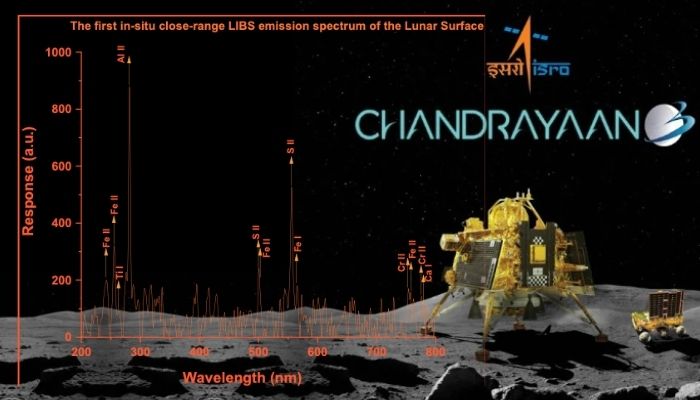The space agency has also conveyed that the existence of oxygen, calcium, and iron has been discovered.
Having disclosed data from an instrument focused on studying the lunar surface’s temperature profile, the Indian Space Research Organisation (ISRO) announced on Tuesday that another instrument onboard Chandrayaan-3 has identified the presence of various elements on the Moon.
Of particular significance is its ability to detect signals that provide evidence for the existence of Sulphur, a finding that had not been directly confirmed until now.
The Laser-Induced Breakdown Spectroscopy (LIBS) instrument carried by Chandrayaan-3’s Rover has achieved groundbreaking in-situ measurements of the elemental composition near the Moon’s South Pole. These measurements have unequivocally established the presence of Sulphur (S) in the region, a feat not achievable with the instruments onboard the orbiters, as outlined in a statement by ISRO.
“Initial analysis… has brought to light the occurrence of Aluminum (Al), Sulphur (S), Calcium (Ca), Iron (Fe), Chromium (Cr), and Titanium (Ti) on the lunar surface. Subsequent measurements have unveiled the existence of Manganese (Mn), Silicon (Si), and Oxygen (O). A comprehensive inquiry into the presence of Hydrogen is currently in progress,” the statement further elaborated.
One of the primary scientific goals of the Chandrayaan-3 mission is to amass information about the presence and distribution of diverse elements on the Moon. This objective is being pursued by multiple instruments. The LIBS instrument, engineered by ISRO’s Laboratory for Electro-Optics Systems (LEOS), employs a high-energy pulsar to induce plasma from rocks or soil. In the plasma state, elements emit distinct wavelengths of radiation, facilitating their identification, as elucidated by ISRO.
The rover also carries another instrument named the Alpha Particle X-Ray Spectrometer, which is designed to investigate the elemental makeup of the lunar surface.
The elements identified by the LIBS instrument are all recognized constituents of the Moon. This information contributes to the current understanding of lunar composition. For instance, the confirmation of Sulphur’s presence holds the potential to enhance our comprehension of lunar origins and development. Given that Sulphur commonly originates from volcanic processes, its detection on the Moon could provide valuable insights into the lunar past and its overall constitution.
“The data released by ISRO from Chandrayaan-3 requires comprehensive processing and analysis to extract more meaningful insights. Currently, ISRO is providing glimpses into the types of experiments conducted on the Moon and the operations of the various instruments,” explained Anil Bhardwaj, the director of the Ahmedabad-based Physical Research Laboratory, which has played a significant role in the Chandrayaan-3 mission, including the development of the ChaSTE (Chandra’s Surface Thermophysical Experiment) deployed on the lander module.
Bhardwaj further clarified, “For instance, the information regarding surface temperatures disclosed on Sunday presents just a partial snapshot of the readings taken by the ChaSTE instrument. These readings vary over time. The instruments aboard Chandrayaan-3 are amassing an extensive volume of data, conducting numerous observations, and executing multiple experiments simultaneously. This data is being transmitted to ground stations. Once the mission concludes, experts specialized in these domains will meticulously analyze this data. Only then can we ascertain the novel or insightful discoveries arising from the mission.”
In essence, the process of deriving significant findings from the Chandrayaan-3 mission’s data involves intricate analysis and in-depth research conducted by specialized scientists after the mission’s completion.

